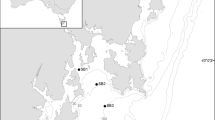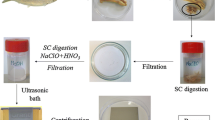Abstract
The chlorophyll derivatives, especially pyrochlorins, from macrobentho-pelagic fecal pellets were separated and identified using reversed-phase high-per-formance liquid chromatography-mass spectrometry (HPLC-MS). HPLC-frit-fast atom bombardment (FAB)-MS analysis of fecal pellet extracts was performed, and the ions at m/z (mass-to-charge ratio), 534 [M]+, 827 [M+H]+ and 812 [M]+ as base peaks contirm the presence of pyropheophorbide a, pyropheophytin b and pyropheophytin a, respectively. Identification of pyrochlorins in fecal pellets suggests that decarbomethoxylation of chlorophylls can occur during bentho-pelagic grazing and that pyrochlorins in sedimentary environments may be derived in part from fecal pellets.
Similar content being viewed by others
Literature cited
Billett, D. S. M., Lampitt, R. S., Rice, A. L., Mantoura, R. F. C. (1983). Seasonal sedimentation of phytoplankton to the deepsea benthos. Nature, Lond. 302: 520–522
Carpenter, S. R., Bergquist, A. M. (1985). Experimental tests of grazing indicators based on chlorophyll-a degradation products. Arch Hydrobiol. 102: 303–317
Carpenter, S. R., Elser, M. M., Elser, J. J. (1986). Chlorophyll production, degradation, and sedimentation: implications for paleolimnology. Limnol. Oceanogr. 31: 112–124
Carpenter, S. R., Leavitt, P. R., Elser, J. J., Elser, M. M. (1988). Chlorophyll budgets: response to food web manipulation. Biogeochemistry (Dordrecht) 6: 79–90
Eckardt, C. B., Carter, J. F., Maxwell, J. R. (1990). Combined liquid chromatography/mass spectrometry of tetrapyrroles of sedimentary significance. Energy & Fuels 4: 741–747
Eckardt, C. B., Keely, B. J., Maxwell, J. R. (1991). Identification of chlorophyll transformation products in a lake sediment by combined liquid chromatography-mass spectrometry. J. Chromat. 557: 271–288
Hallegraeff, G. M. (1981). Seasonal study of phytoplankton pigments and species at a coastal station off Sydney: importance of diatoms and nanoplankton. Mar. Biol. 61: 107–118
Hata, K., Handa, N., Ohta, K. (1980). Early diagenetic change in chlorophyll a in sediment collected from Lake Biwa. Chikyukagaku [Geochemistry] 14: 23–29
Hurley, J. P., Armstrong, D. E. (1990). Fluxes and transformations of aquatic pigments in Lake Mendota, Wisconsin (1990). Limnol. Oceanogr. 35: 384–398
Jacobsen, T. R. (1978). A quantitative method for the separation of chlorophylls a and b from phytoplankton pigments by high pressure liquid chromatography. Mar. Sci. Communs 4: 33–47
Keely, B. J., Brereton, R. G., Maxwell, J. R. (1988). Occurrence and significance of pyrochlorins in a lake sediment. Org. Geochem. 13: 801–805
Lampitt, R. S., Noji, T., Bodungen, B. (1990). What happens to zooplankton faecal pellets? Implications for material flux. Mar. Biol. 104: 15–23
Pennington, F. C., Strain, H. H., Svec, W. A., Katz, J. J. J. (1964). Preparation and properties of pyrochlorophyll a, methyl pyrochlorophyllide a, pyropheophytin a, and methyl pyropheophorbide a derived from chlorophyll by decarbomethoxylation. J. Am. chem. Soc. 86: 1418–1426
Sanger, J. E. (1988). Fossil pigments in paleoecology and paleolimnology. Palaeogeogr. Palaeoclim. Palaeoecol. 62: 343–359
Vernet, M., Lorenzen, C. J. (1987 a). The relative abundance of pheophorbide a and pheophytin a in temperate marine waters. Limnol. Oceanogr. 32: 352–358
Vernet, M., Lorenzen, C. J. (1987 b). The presence of chlorophyll b and the estimation of phaeopigments in marine phytoplankton. J. Plankton Res. 9: 255–265
Welschmeyer, N. A., Lorenzen, C. J. (1985). Chlorophyll budgets: zooplankton grazing and phytoplankton growth in a temperate fjord and the Central Pacific Gyres. Limnol. Oceanogr. 30: 1–21
Zpata, M., Ayala, A. M., Franco, J. M., Garrido, J. L. (1987). Separation of chlorophylls and their degradation products in marine phytoplankton by reversed-phase high-performance liquid chromatography. Chromatographia 23: 26–30
Author information
Authors and Affiliations
Additional information
Communicated by T. Ikeda, Niigata
Rights and permissions
About this article
Cite this article
Otsuki, A., Kaneda, Y. & Hashimoto, S. Identification and significance of pyrochlorins in fecal pellets of the marine malacostracan crustaceans Heptacarpus rectirostris and Palaemon pacificus . Marine Biology 115, 463–467 (1993). https://doi.org/10.1007/BF00349845
Received:
Accepted:
Issue Date:
DOI: https://doi.org/10.1007/BF00349845




